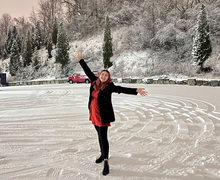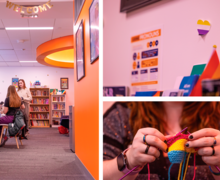SUNY-ESF helps plan a sustainable village and learning community in Haiti
Alexandra Moreo | Photo Editor
Architecture students at SUNY-ESF will help create a sustainable village in Haiti.
Researchers and students at SUNY-ESF are trying to transform the small Haitian community of Arcahaie into an example of sustainability.
With an $800,000 grant from the W.K. Kellogg Foundation, the State University of New York College of Environmental Science and Forestry is collaborating with a team of other SUNY schools and international nonprofits to design and build a sustainable village and learning community in Arcahaie.
SUNY-ESF will provide expertise in environmental sustainability to help the community minimize its impacts on the environment and even restore local ecology.
Students of landscape architecture will get the chance to participate directly in the design of the village through an advanced studio course run by professors Maren King and Emanuel Carter Jr.
Although King said in an email that it’s not unusual for students in the department to engage in real-world projects with communities, the planning of this village presents a unique challenge for those enrolled in the studio.
S. Scott Shannon, associate provost for instruction and dean of the graduate school, said working with such a diverse group of stakeholders will be a great learning experience in negotiating the needs and interests of multiple parties.
There is a widespread group of organizations working on the project, with schools from the SUNY system and nonprofits like the Haiti Development Institute and YouthBuild International contributing ideas and knowledge.
King said designs will incorporate practices that “resonate culturally and environmentally.”
“Our students are not learning how to design in purely environmental or aesthetic terms,” Shannon said. “Their designs must respect and reflect the people and the community they are serving, as well the environmental context they find.”
The vision of the village is centered on needs identified by community members, said Pierre Noel and Jacky Poteau of the Haiti Development Institute.
They said they structured the design process to ensure community partnership and engagement continued in projects stemming from the original vision. It is also a goal to keep the community active in plans for the project through various local institutions, they said.
These plans include Leadership in Energy and Environmental Design certified buildings, ecological restoration, sustainable water and waste treatment and conservation, among other things.
Noel and Poteau added the village should become not just a sustainable “haven behind walls,” but benefit and serve the populations around it. The learning community will include educational opportunities and may incorporate sustainable agricultural operations, social and health services and other elements designed to promote sustainable economic development.
Shannon said he doesn’t know of many similar efforts in existence.
Poteau and Noel added the project is spearheading a “new paradigm” in development because many similar initiatives are pre-planned and initiated in a top-down manner. This village has been following the community’s vision from the start.
While Arcahaie will likely take about five years to complete, when it is finished it will serve as an example of how communities can improve lives and fight poverty while promoting sustainable living.
King said the ultimate goal of the village is to bring about “social, economic, and environmental change … sustained under local leadership.”
Planners said they hope if all goes well, people’s perceptions of Haiti may evolve beyond images of hurricanes to a picture of progress.
Published on October 17, 2017 at 9:17 pm
Contact Maizy: mtludden@syr.edu





